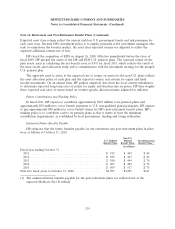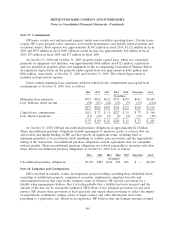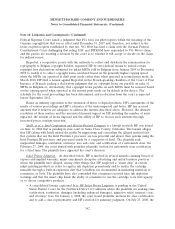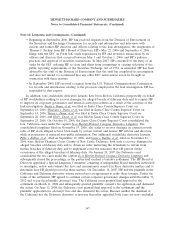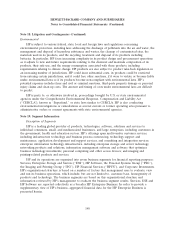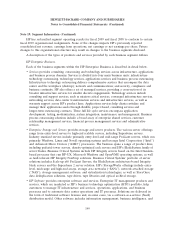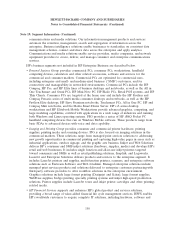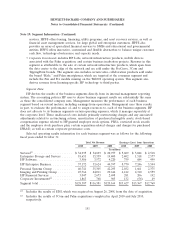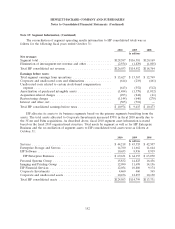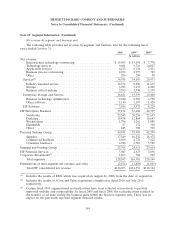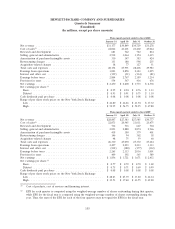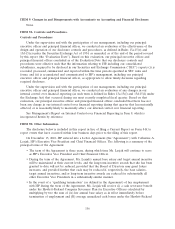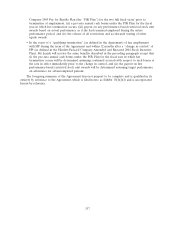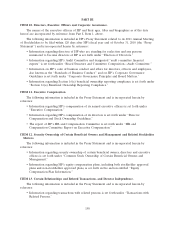HP 2010 Annual Report Download - page 157
Download and view the complete annual report
Please find page 157 of the 2010 HP annual report below. You can navigate through the pages in the report by either clicking on the pages listed below, or by using the keyword search tool below to find specific information within the annual report.HEWLETT-PACKARD COMPANY AND SUBSIDIARIES
Notes to Consolidated Financial Statements (Continued)
Note 19: Segment Information (Continued)
HP has reclassified segment operating results for fiscal 2009 and fiscal 2008 to conform to certain
fiscal 2010 organizational realignments. None of the changes impacts HP’s previously reported
consolidated net revenue, earnings from operations, net earnings or net earnings per share. Future
changes to this organizational structure may result in changes to the business segments disclosed.
A description of the types of products and services provided by each business segment follows.
HP Enterprise Business.
Each of the business segments within the HP Enterprise Business is described in detail below.
•Services provides consulting, outsourcing and technology services across infrastructure, applications
and business process domains. Services is divided into four main business units: infrastructure
technology outsourcing, technology services, applications services and business process outsourcing.
Infrastructure technology outsourcing delivers comprehensive services that encompass the data
center and the workplace (desktop); network and communications; and security, compliance and
business continuity. HP also offers a set of managed services, providing a cross-section of its
broader infrastructure services for smaller discrete engagements. Technology services include
consulting and support services, such as mission critical services, converged infrastructure services,
networking services, data center transformation services and infrastructure services, as well as
warranty support across HP’s product lines. Applications services help clients revitalize and
manage their applications assets through flexible, project-based, consulting services and
longer-term outsourcing contracts. These full life cycle services encompass application
development, testing, modernization, system integration, maintenance and management. Business
process outsourcing solutions include a broad array of enterprise shared services, customer
relationship management services, financial process management services and administrative
services.
•Enterprise Storage and Servers provides storage and server products. The various server offerings
range from entry-level servers to high-end scalable servers, including Superdome servers.
Industry standard servers include primarily entry-level and mid-range ProLiant servers, which run
primarily Windows, Linux and Novell operating systems and leverage Intel Corporation (‘‘Intel’’)
and Advanced Micro Devices (‘‘AMD’’) processors. The business spans a range of product lines,
including pedestal-tower servers, density-optimized rack servers and HP’s BladeSystem family of
server blades. Business Critical Systems include HP Integrity servers based on the Intel Itanium-
based processor that run HP-UX, Microsoft Windows and OpenVMS operating systems, as well
as fault-tolerant HP Integrity NonStop solutions. Business Critical Systems’ portfolio of server
solutions includes Scale-up x86 ProLiant Servers, the BladeSystem architecture-based Integrity
blade servers and the Superdome 2 server solution. HP’s StorageWorks offerings include entry-
level, mid-range and high-end arrays, storage area networks (‘‘SANs’’), network attached storage
(‘‘NAS’’), storage management software, and virtualization technologies, as well as StoreOnce
data deduplication solutions, tape drives, tape libraries and optical archival storage.
•HP Software provides enterprise software and services. Enterprise IT management products and
services, which are marketed as HP’s business technology optimization (BTO) portfolio, help
customers to manage IT infrastructure and services, operations, applications, and business
processes and to automate data center operations and IT processes. Solutions are delivered in
the form of traditional software licenses and, in some cases, via a software-as-a-service (SaaS)
distribution model. Other software includes information management, business intelligence, and
149


